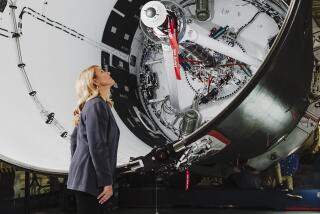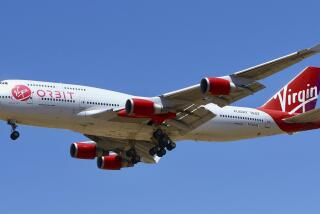Rocketdyne’s Thrust Is New Projects
- Share via
As the new president of Rocketdyne, the rocket engine division of Rockwell International that builds the main engines for the space shuttles, Robert D. Paster would seem to have inherited a rock solid business.
Rocketdyne’s order backlog this year alone jumped $500 million, to $3 billion, and its 1989 sales topped $1 billion for the first time. The division, which first set up shop in the San Fernando Valley in the early 1950s and is now based in Canoga Park, counts 9,500 employees and expects to add 500 workers next year. All this comes at a time when other aerospace companies are slashing their work forces.
Rocketdyne’s advantage is that 75% of its business is so-called “commercial work,” such as the NASA-operated shuttle, and has been exempt thus far from the defense spending slowdown that is forcing other companies to cut employment. “We’re not in the tank business, we’re in the business of space systems,” said Paster, who became president in October.
While federal spending for some defense programs is being cut, spending for space programs jumped 16% in the fiscal year that began Oct. 1, to $12.4 billion.
But Paster, 49, feels pressure anyway. He can’t count on similar spending gains for space in the future because budget deficit problems could pare funding for Rocketdyne’s pet projects.
For instance, Rocketdyne has built engines for every space shuttle. But even that could change one day. Three years ago, NASA awarded a $198-million contract to Pratt & Whitney to develop a new turbopump for the shuttle’s main engines, that is, a pump that would outperform the current one built by Rocketdyne. (The pump forces fuel through the engine at high speed.) Pratt & Whitney, a unit of United Technologies, is about to begin testing its version of the product.
The contract signaled that Rocketdyne could not take the shuttle engine program for granted, said Wolfgang H. Demisch, an aerospace analyst for UBS Securities in New York. “Clearly there will be more competition,” he said.
Also, Rocketdyne is not totally exempt from defense spending cutbacks because the military is a major user of the rockets that Rocketdyne designs engines for, said Paul H. Nisbet, an aerospace analyst with Prudential-Bache Securities in New York. “The ‘commercial programs,’ as they are called, are largely supported by the military,” he said.
So Paster’s task is to secure more new projects--and keep those it already has--so that Rocketdyne maintains its momentum. “We may not grow as fast as we want to grow, but I don’t see us going into a decay unless something unforeseen happens,” he said.
To land contracts, he must deliver current orders as promised--correctly built, on time and within budget. Otherwise, Rocketdyne risks jeopardizing the willingness of Congress and the public to continue paying for the projects.
For example, one of Rocketdyne’s new projects is a $1.6-billion, multi-year contract to develop the electrical power system for a proposed space station that might be built by the year 2000. The station likely would be assembled with pieces hoisted into space by the shuttles or new “heavy vehicle” unmanned rockets.
Fortunately for Rocketdyne, the space station deal is a “cost-plus” contract, meaning the government pays for any cost overruns. But Rocketdyne still has incentives. The contract includes government “awards,” which are paid depending on how well Rocketdyne does its job. In a good year, the awards can total in the millions of dollars.
To keep programs as efficient as possible, Rocketdyne and NASA together have spent $100 million in recent years to install robots and otherwise modernize the company’s plants to cut Rocketdyne’s production costs. Rocketdyne produces a shuttle engine that costs NASA $34 million, down from $45 million originally, and Paster wants each engine to sell for $25 million in 1992-93. The robotics, reductions in the hundreds of welds needed to assemble the engines and other improvements enabled Rocketdyne to cut the engine’s cost.
A project Rocketdyne would like to win is to build the engines for a proposed “advanced launch system,” or ALS. The system would be an unmanned, expendable rocket capable of launching up to 200,000 pounds worth of cargo--compared with the 55,000-pound limit of the shuttles, Paster said.
The ALS is meant to be built at much lower cost than the powerful rocket engines that sent astronauts to the moon. The government wants the cost for the ALS to be between $300 and $500 per pound launched, compared with more than $2,000 per pound on current unmanned rockets today. Rocketdyne is competing against Pratt & Whitney and a third company, Aerojet-General, a unit of GenCorp Inc., for the ALS program.
Rocketdyne has three contracts covering development of an ALS engine, totaling $81 million, that were awarded last summer and extend for up to 3 1/2 years. If ALS funding continues, the vehicles might be ready in the mid-1990s to help build the space station.
Rocketdyne also remains busy making engines for General Dynamics Corp.’s Atlas and McDonnell Douglas Corp.’s Delta rockets, which were developed as missiles but are now being used to launch commercial and military payloads into orbit.
After the Challenger space shuttle accident on Jan. 28, 1986, the federal government opened the way for private, commercial launches of space cargoes. Three rocket companies, McDonnell Douglas, General Dynamics and Martin Marietta Corp. are expected to dominate the commercial business. That Rocketdyne makes engines for two of the big three companies is one reason for its gains in backlog and employment.
But Paster also can’t sit back and wait for the government to send money if he wants to foster Rocketdyne’s growth. He’s got to keep hustling for contracts.
Consider: Rocketdyne was not originally asked to bid on developing engines for the proposed National Aerospace Plane, or NASP, a hypersonic jet that would be capable of flying from Washington to Tokyo in two hours. Rocketdyne went ahead and spent millions of dollars designing NASP engine concepts that caught the attention of federal officials, and it’s now vying with Pratt & Whitney to build engines for that plane as well.
There’s no guarantee that the government will want to build more than the one experimental NASP model it has ordered for $3.3 billion. Even if work continues, scientists have said a commercial version of the plane could not be built until at least the year 2020.
Still, Paster had to act or risk getting left behind. “The task for the guy on top is to make sure he sets the company up for the decisions that are going to keep it humming five, 10, 15 years from how,” said analyst Demisch.
Paster joined Rocketdyne after getting his bachelor’s degree in aeronautical engineering from the University of Michigan in 1962. He began as a propulsion systems engineer for the Gemini, Apollo and other space projects, and eventually held management posts in nearly all of Rocketdyne’s fields, including the Atlas/Delta rocket and Peacekeeper missile programs.
In 1983, he was named vice president of advanced programs--in charge of Rocketdyne’s work on future rockets--and he became program manager of the shuttle’s main engine work in 1986.
Paster said his background makes him no less a businessman than engineer. “The space shuttle main engine division is a $400-million business, with manufacturing, quality, engineering, business management, purchasing, everything it takes to run a business,” he said.
It also takes public relations, as Paster is finding out. In recent months, neighborhood and environmental groups have pressed Rocketdyne to shut down a “hot lab” at its 2,100-acre property in the Santa Susana Mountains, where the company used to perform nuclear work such as fabricating nuclear fuel and salvaging plutonium from spent nuclear power fuel rods.
Rocketdyne plans to close the lab next year, and Paster said recently that the closure would mark the end of Rocketdyne’s nuclear work. Most of the Santa Susana site is devoted to testing Rocketdyne’s engines.
Paster’s test as a manager also will go on, as the U.S. government sorts out which space programs it can afford and Rocketdyne tries to win a bigger share of the space market. “We’ve been very successful the last several years,” he said. “I’m not going to come in here and turn Rocketdyne inside out.”
More to Read
Inside the business of entertainment
The Wide Shot brings you news, analysis and insights on everything from streaming wars to production — and what it all means for the future.
You may occasionally receive promotional content from the Los Angeles Times.











